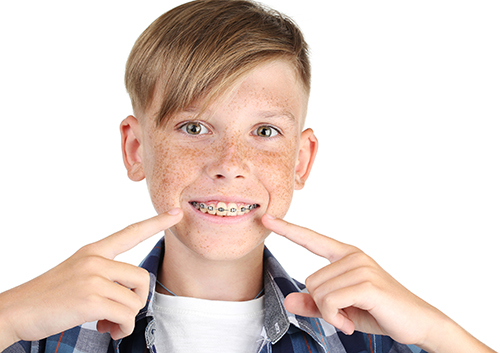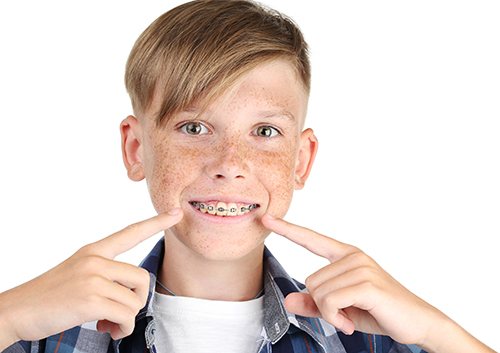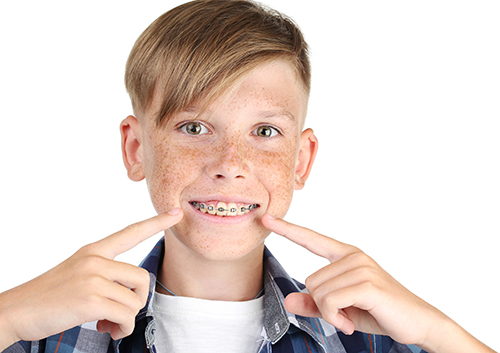July 13th, 2022

Analyzing strong points, looking for potential problems, making comparisons—it’s bracketology time! Nope, not basketball (although we hear they have something similar), but a brief analysis of your orthodontic options when it comes to choosing a winning bracket.
If you’re getting braces, you’re probably already familiar with how they work—brackets are bonded to the teeth to hold an archwire, which provides gentle, controlled pressure to move the teeth into alignment. But within that basic bracket-and-wire system, there are several different bracket designs available to you at our Chicago, IL orthodontic office. Let’s see what the scouting report has turned up on our final four, pointing out their distinct advantages as well as some potential mismatches.
Traditional metal brackets
Advantages:
- Traditional braces with metal brackets are effective for more than just straightening teeth. They can be used to correct rotated teeth, differences in tooth height, and bite problems. For severe bite and alignment problems, traditional braces are most often the right choice.
- Metal construction makes these brackets able to handle the controlled pressure needed to treat serious malocclusions.
- Cost-effective. These are usually the least expensive option.
Potential Disadvantage:
Clear/Ceramic Brackets
Advantages:
- Lack of visibility! Whether you go for clear brackets or brackets tinted to match your enamel, you’ll be keeping a low-profile with this choice.
- Stronger and more stain-resistant than ever before, using the latest in ceramic, porcelain, or plastic materials.
Potential Disadvantages:
- Not as durable. Unlike metal, these clear brackets can crack or break. If you play a contact sport, these might not be for you.
- Some ceramic brackets are larger than other choices, so might be recommended only for the top teeth.
- Clear or tinted brackets can be more expensive.
Self-Ligating Brackets
Advantages:
- These brackets use a clip or trapdoor mechanism to hold your archwire without the need of bands. Ceramic options are available if you want an even more discreet appearance.
- Can be more comfortable with less friction between wire and bracket.
Potential Disadvantages:
- Self-ligating braces are generally more expensive.
Lingual Braces
Advantages:
- Lingual braces use metal brackets, but they attach to the back of each tooth for almost invisible bite correction.
- Custom-made. Lingual brackets can be designed and fabricated to fit your individual teeth perfectly.
Potential Disadvantages:
- Trickier to clean because of their placement behind teeth.
- Might not be suitable for a deep bite if there’s not enough clearance between top and bottom teeth.
- Initial discomfort caused by the tongue’s contact with the braces when you speak and eat.
- Custom-made brackets are more expensive.
So that’s a brief rundown of your bracket choices. But, unlike sports bracketology, there are no losers here! Dr. Karen Seder can give you the pros and cons of each bracket design, so you can make an informed decision based on the kind of braces which will work best for you. With coaching like that, no matter which bracket option you choose, the final result is the same—a winning smile!
July 6th, 2022

You’re going to the game! And no matter which sport you follow, there’s so much to enjoy—the best athletes, exciting play, hometown pride—and those delicious concession stands! But if you’re wearing braces, your team spirit might be flagging. Here are a few ideas to help keep your food choices out of foul territory.
You know that you should avoid the foods that can damage braces or stick around your wires and brackets. This means any snacks that are sticky, chewy, hard, or crunchy are benched. So most of the traditional game foods—peanuts, popcorn, nachos, licorice—are just not safe for traditional metal or ceramic braces. Let’s save those for next season.
So what is on the program? You still have many great choices.
- Ice Cream. A favorite that’s easy on your braces (no nuts or caramel, please). If you want a healthier option, try frozen yogurt or a smoothie.
- Hearty Snacks. Pretzels and pizza can be too thick and chewy. Go for the mac and cheese, chili, or deli meats on soft bread. And remember, small bites! Check with us to see if hamburgers and hot dogs are safe for your braces.
- Soft Candies and Cookies. Licorice, caramels, and crunchy cookies are out, but soft chocolate bars and moist, tender cookies are still on the menu.
- Sodas and sports drinks can create a sugary and/or acidic environment which can damage enamel over time. If you do indulge, try to rinse with water ASAP.
Stadium and arena menus contain a lot of starches and sugars, which stick to braces and fuel cavity-causing bacteria. So it’s best to go easy on the snacks. But you don’t have to give up a half-time treat entirely—just enjoy in moderation and be sure to brush thoroughly when you get home.
If you wear clear aligners, your choices are simpler. You can remove your aligners, eat normally, and clean your teeth thoroughly before replacing them. But one flag on this play—remember that you’re supposed to wear your aligners for a set number of hours each day. You don’t want to be putting your treatment behind schedule if the game goes into triple overtime. Keep your eye on the clock, and you should be fine.
Dr. Karen Seder and our Chicago, IL team are always happy to recommend the best food options for your individual orthodontic treatment, and we can help you select a roster of safe and healthy choices. You might miss out on a few of your favorite sports snacks right now, but let’s remember the true fan’s motto: There’s always next year! Taking care of your braces and teeth means faster treatment and healthier teeth. Your All-Star smile will be worth it!
July 6th, 2022

You’re going to the game! And no matter which sport you follow, there’s so much to enjoy—the best athletes, exciting play, hometown pride—and those delicious concession stands! But if you’re wearing braces, your team spirit might be flagging. Here are a few ideas to help keep your food choices out of foul territory.
You know that you should avoid the foods that can damage braces or stick around your wires and brackets. This means any snacks that are sticky, chewy, hard, or crunchy are benched. So most of the traditional game foods—peanuts, popcorn, nachos, licorice—are just not safe for traditional metal or ceramic braces. Let’s save those for next season.
So what is on the program? You still have many great choices.
- Ice Cream. A favorite that’s easy on your braces (no nuts or caramel, please). If you want a healthier option, try frozen yogurt or a smoothie.
- Hearty Snacks. Pretzels and pizza can be too thick and chewy. Go for the mac and cheese, chili, or deli meats on soft bread. And remember, small bites! Check with us to see if hamburgers and hot dogs are safe for your braces.
- Soft Candies and Cookies. Licorice, caramels, and crunchy cookies are out, but soft chocolate bars and moist, tender cookies are still on the menu.
- Sodas and sports drinks can create a sugary and/or acidic environment which can damage enamel over time. If you do indulge, try to rinse with water ASAP.
Stadium and arena menus contain a lot of starches and sugars, which stick to braces and fuel cavity-causing bacteria. So it’s best to go easy on the snacks. But you don’t have to give up a half-time treat entirely—just enjoy in moderation and be sure to brush thoroughly when you get home.
If you wear clear aligners, your choices are simpler. You can remove your aligners, eat normally, and clean your teeth thoroughly before replacing them. But one flag on this play—remember that you’re supposed to wear your aligners for a set number of hours each day. You don’t want to be putting your treatment behind schedule if the game goes into triple overtime. Keep your eye on the clock, and you should be fine.
Dr. Karen Seder and our Chicago, IL team are always happy to recommend the best food options for your individual orthodontic treatment, and we can help you select a roster of safe and healthy choices. You might miss out on a few of your favorite sports snacks right now, but let’s remember the true fan’s motto: There’s always next year! Taking care of your braces and teeth means faster treatment and healthier teeth. Your All-Star smile will be worth it!
July 6th, 2022

You’re going to the game! And no matter which sport you follow, there’s so much to enjoy—the best athletes, exciting play, hometown pride—and those delicious concession stands! But if you’re wearing braces, your team spirit might be flagging. Here are a few ideas to help keep your food choices out of foul territory.
You know that you should avoid the foods that can damage braces or stick around your wires and brackets. This means any snacks that are sticky, chewy, hard, or crunchy are benched. So most of the traditional game foods—peanuts, popcorn, nachos, licorice—are just not safe for traditional metal or ceramic braces. Let’s save those for next season.
So what is on the program? You still have many great choices.
- Ice Cream. A favorite that’s easy on your braces (no nuts or caramel, please). If you want a healthier option, try frozen yogurt or a smoothie.
- Hearty Snacks. Pretzels and pizza can be too thick and chewy. Go for the mac and cheese, chili, or deli meats on soft bread. And remember, small bites! Check with us to see if hamburgers and hot dogs are safe for your braces.
- Soft Candies and Cookies. Licorice, caramels, and crunchy cookies are out, but soft chocolate bars and moist, tender cookies are still on the menu.
- Sodas and sports drinks can create a sugary and/or acidic environment which can damage enamel over time. If you do indulge, try to rinse with water ASAP.
Stadium and arena menus contain a lot of starches and sugars, which stick to braces and fuel cavity-causing bacteria. So it’s best to go easy on the snacks. But you don’t have to give up a half-time treat entirely—just enjoy in moderation and be sure to brush thoroughly when you get home.
If you wear clear aligners, your choices are simpler. You can remove your aligners, eat normally, and clean your teeth thoroughly before replacing them. But one flag on this play—remember that you’re supposed to wear your aligners for a set number of hours each day. You don’t want to be putting your treatment behind schedule if the game goes into triple overtime. Keep your eye on the clock, and you should be fine.
Dr. Karen Seder and our Chicago, IL team are always happy to recommend the best food options for your individual orthodontic treatment, and we can help you select a roster of safe and healthy choices. You might miss out on a few of your favorite sports snacks right now, but let’s remember the true fan’s motto: There’s always next year! Taking care of your braces and teeth means faster treatment and healthier teeth. Your All-Star smile will be worth it!





 Website Powered by Sesame 24-7™
Website Powered by Sesame 24-7™